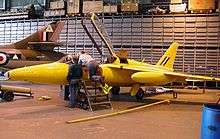Folland Aircraft
 Gnat T.1 of No. 4 Flying Training School, RAF Valley, in 1967 | |
| Folland Aircraft Limited | |
Formerly called | British Marine Aircraft Limited |
| Limited company | |
| Industry | Aircraft manufacturing |
| Fate | Acquired by Hawker Siddeley in 1959 |
| Founded | 1936 as British Marine Aircraft Limited |
| Defunct | 1963 |
Key people | Henry Folland, W.E.W. Petter |
Folland Aircraft was a British aircraft manufacturing company which was active between 1937 and 1963.
History

British Marine Aircraft Limited was formed in February 1936 to produce Sikorsky S-42-A flying boats under licence in the UK. The company built a factory on the western side of the Hamble peninsula with a slipway to Southampton Water. Although the construction of one Sikorsky based aircraft was started at Hamble the company was suffering losses and mergers with other British aircraft companies were considered by the liquidators including one with Westland Aircraft which was not concluded. Following failure of the Westland deal the liquidators appointed a new management board in May 1937 to stem the losses and re-organise the company which was renamed later in 1937 to Folland Aircraft Company after Henry P. Folland the company's managing director and aircraft designer.[1]
Folland began aircraft assembly at Hamble making parts for Bristol Blenheim and Beaufort bombers. Follands also made 15,000 rear portions out of the 22,000 constructed for the Supermarine Spitfire. Folland later took on sub-contract work making parts for de Havilland Mosquitos and Vickers Wellingtons.[2]
The first aircraft of its own design to fly was the Folland Fo.108 in 1940. Designed and built to meet the Air Ministry Specification 43/47 for a flying engine testbed it was generally known as the 43/47 or by the nickname "Folland Frightful" from its unusual appearance.
The Folland F.115 and F.116 designs were tendered to meet Specification E.28/40 for a research aircraft to investigate the issues of landing weight for aircraft operating from carriers. The F.116 design was powered by a Centaurus radial and used a variable incidence wing on an airframe estimated at around 18,250 lb (8,300 kg). Two prototypes were ordered but the project was cancelled in 1943 as most of the problems had already been overcome, and neither prototype was completed.[3]
W. E. W. Petter, who had designed the Westland Lysander, English Electric Canberra and English Electric Lightning, joined the company as managing director in 1950.[4] He designed the Folland Midge as an unarmed proof-of-concept demonstrator for a lightweight jet fighter which first flew 11 August 1954.[4] This was followed by the Folland Gnat, the prototype of which, serial number G-39-2, flew on 18 July 1955.[4] Although RAF interest in the possibilities for using the Gnat as a fighter had waned, Folland identified another potential use for the type as an advanced trainer aircraft. The prototype Gnat Trainer conducted its maiden flight on 31 August 1959. Both were built at Hamble until the 1960s with the final Gnat T.1 for the RAF being delivered in May 1965. Follands used an airfield at Chilbolton formerly RAF Chilbolton where they Flight Tested the Folland Midge and the versions of the Folland Gnat.
In 1959 Folland was acquired by Hawker Siddeley who dropped the Folland name in 1963. Ultimately, Folland became part of British Aerospace (BAe). Although Hamble airfield closed in 1986, BAe continued to use the premises there for the production of major assemblies for Harrier and Hawk jets.[2]
Aircraft
Missiles
Sport
The factory also had its own football team created by the workers in 1938, the team is still playing under the name of GE Hamble F.C., the name of the new parent company that now own the factory.[5]
See also
References
| Wikimedia Commons has media related to Folland Aircraft. |
- ↑ Fagan, Dave. 'Hamble' Aviation in Hampshire UK 1900 to 2000 Retrieved 20 May 2005
- 1 2 Haselden, Derek. Aviation at Hamble (8 January 2005) Retrieved 20 May 2005
- ↑ Buttler British Secret Projects: Fighters and Bombers 1935–1950. Appendix 2
- 1 2 3 'Folland', British Aircraft Directory (1 May 2004) Retrieved 1 July 2017
- ↑ Andrew (2012-01-17). "Hopping Around Hampshire: 18. GE Hamble FC". Hoppingaroundhampshire.blogspot.co.uk. Retrieved 2012-11-17.
External links
- The Folland E.28/40 a 1946 Flight article
Timeline of British aerospace companies since 1955 | |||||||||||||||||||||||||||||||||||||||||||||||||
|---|---|---|---|---|---|---|---|---|---|---|---|---|---|---|---|---|---|---|---|---|---|---|---|---|---|---|---|---|---|---|---|---|---|---|---|---|---|---|---|---|---|---|---|---|---|---|---|---|---|
| 1950s | 1960s | 1970s | 1980s | 1990s | 2000s | ||||||||||||||||||||||||||||||||||||||||||||
| 5 | 6 | 7 | 8 | 9 | 0 | 1 | 2 | 3 | 4 | 5 | 6 | 7 | 8 | 9 | 0 | 1 | 2 | 3 | 4 | 5 | 6 | 7 | 8 | 9 | 0 | 1 | 2 | 3 | 4 | 5 | 6 | 7 | 8 | 9 | 0 | 1 | 2 | 3 | 4 | 5 | 6 | 7 | 8 | 9 | 0 | 1 | 2 | 3 | 4 |
| Short Brothers and Harland Ltd. | Short Brothers Ltd. | Short Brothers plc[7] | |||||||||||||||||||||||||||||||||||||||||||||||
| Handley Page | |||||||||||||||||||||||||||||||||||||||||||||||||
| F. G. Miles | Beagle Aircraft[1] | ||||||||||||||||||||||||||||||||||||||||||||||||
| Auster | |||||||||||||||||||||||||||||||||||||||||||||||||
| Scottish Aviation[2] | British Aerospace (BAe) | BAE Systems | |||||||||||||||||||||||||||||||||||||||||||||||
| Blackburn | Hawker Siddeley Aviation Hawker Siddeley Dynamics | ||||||||||||||||||||||||||||||||||||||||||||||||
| Avro | |||||||||||||||||||||||||||||||||||||||||||||||||
| de Havilland | |||||||||||||||||||||||||||||||||||||||||||||||||
| Folland | |||||||||||||||||||||||||||||||||||||||||||||||||
| Hawker Siddeley[3] | |||||||||||||||||||||||||||||||||||||||||||||||||
| Vickers-Armstrongs | British Aircraft Corporation (BAC)[5] | ||||||||||||||||||||||||||||||||||||||||||||||||
| English Electric[4] | |||||||||||||||||||||||||||||||||||||||||||||||||
| Bristol | |||||||||||||||||||||||||||||||||||||||||||||||||
| Hunting | |||||||||||||||||||||||||||||||||||||||||||||||||
| The General Electric Company (GEC) | The Marconi Company | GEC-Marconi/Marconi Electronic Systems | |||||||||||||||||||||||||||||||||||||||||||||||
| The English Electric Company[6] | Marconi plc | ||||||||||||||||||||||||||||||||||||||||||||||||
| |||||||||||||||||||||||||||||||||||||||||||||||||